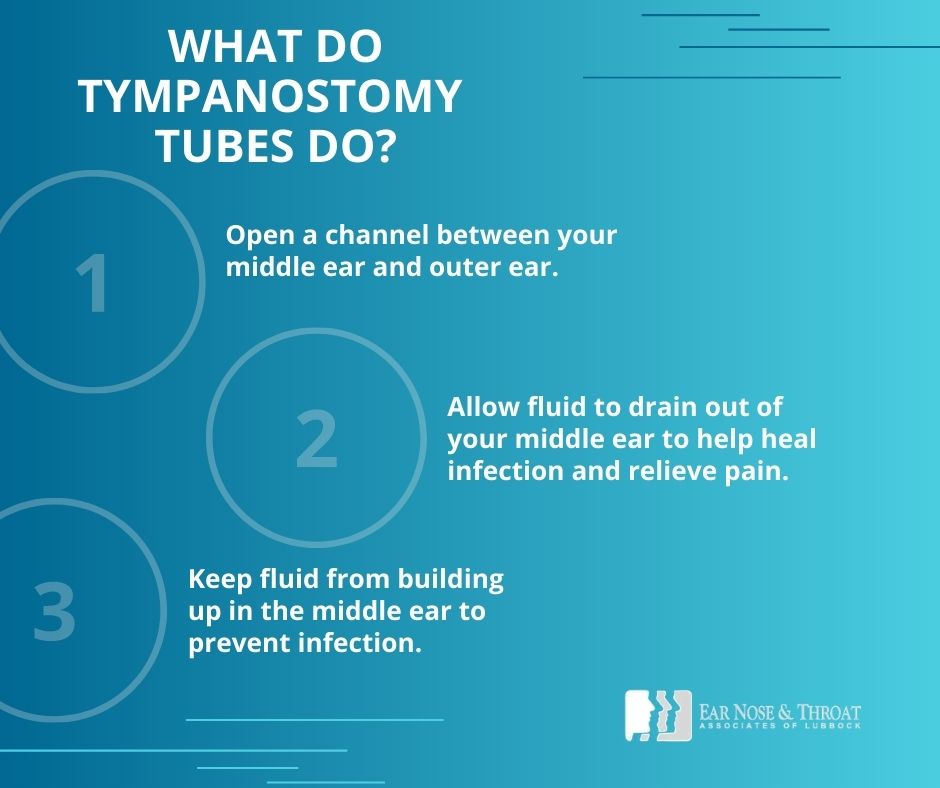What Are Tympanostomy Tubes and Do You Need Them?

You’ve probably heard other parents mention their child getting tubes in their ears. It sounds simple enough when it’s someone else’s child.
But when it’s your baby’s turn, anxiety can rear its head.
We know that any medical procedure on your child can seem scary, regardless of their age, and we want to set your mind at ease. In this post, we’ll talk about who needs tympanostomy tubes, what exactly tympanostomy tubes are, and how they’re inserted.
Who Needs Tympanostomy Tubes?
Most tympanostomy tubes are placed in children, but adults sometimes need them as well. In children, the primary reason for tympanostomy tubes is chronic fluid and infection in the middle ear (otitis media) that doesn’t resolve with antibiotics.
Normally, the eustachian tube ventilates the middle ear, opening and closing to equalize air pressure and allow fluid to drain from our ear to the back of our nose and down our throat. But this channel can become blocked by inflammation, allergies, and infection, causing eustachian tube dysfunction. Air and fluid then build up in the middle ear, leading to pain, pressure, and ear infection.
Eustachian tubes in young children tend to be smaller and more horizontal, so they become blocked more easily than adult eustachian tubes. This is why children often get more ear infections than adults.
An occasional ear infection is easily treated with antibiotics. But chronic otitis media with effusion (fluid) lasts for three months or longer, and recurrent acute otitis media involves multiple isolated ear infections over a period of time —three in six months or four in 12 months. In these cases, tympanostomy tubes replace the function of the blocked eustachian tubes, allowing air and fluid to drain from the middle ear through the outer ear instead.
In adults, fluid buildup in the ear usually just causes discomfort. In young children, however, the fluid can cause hearing loss that leads to delays in speech development.
If repeated ear infections aren’t addressed (or are simply prescribed oral antibiotics over and over again), they can cause:
- Hearing loss.
- Damage to the middle ear and eardrum.
- Gastrointestinal issues or oral thrush from repeated systemic antibiotics.
As tympanostomy tubes ventilate the middle ear, the ear becomes less susceptible to infection. Fluid and pressure no longer impede the eardrum’s function, and hearing returns to normal. By using tympanostomy tubes in children, we hope to ventilate the middle ear until a child grows out of their repeated ear infections.
All About Tympanostomy Tubes
If you’re considering tympanostomy tubes, you likely have questions about the placement procedure. We believe the more you know about the tympanostomy procedure, the more at ease you’ll be.
What Are Tympanostomy Tubes?
Tympanostomy tubes (or ear tubes) are tiny tubes about 2–3 mm long. We find that using flexible rubber tubes causes less trauma to the ear than other tubes on the market, such as thicker plastic or metal tubes.
What Is a Tympanostomy?
A tympanostomy is a procedure in which an ENT surgeon uses a sharp tool to create a very small hole in the tympanic membrane (the eardrum). The surgeon then inserts the tiny tympanostomy tube into the hole to keep it open. Otherwise, the eardrum would heal the hole within a fairly short time, as it does after a myringotomy.
An adult tympanostomy is a simple, five-minute office procedure performed with topical numbing medication. Children are unable to lie still enough for a tympanostomy, however, so their procedures occur in an outpatient surgery center where they can receive anesthesia via a mask. No IVs are necessary, and the procedure is still short and simple.

After Tympanostomy Tube Placement
After receiving the anesthesia for their tympanostomy, it’s not unusual for kids to be a little cranky for the remainder of the day. But by the day after surgery, they should be able to resume normal activities and attend school or daycare. There are no limitations on diet or exercise, and it’s not necessary to try to keep water out of the ears.
We check the patient’s hearing in our office a few weeks after the tubes are placed to ensure improvement. We also schedule follow-up visits to check the tympanostomy tubes every six months until they fall out.
Tympanostomy Tubes Provide Big Benefits
Like any medical procedure, getting tympanostomy tubes in your own or your child’s ears may be intimidating. But tympanostomy tube placement is a simple, easy, low-risk procedure that can relieve discomfort and prevent infection when nothing else seems to help.
We hope you find this information helpful and can look forward to the benefits of tympanostomy tubes without worry!
Dr. Cuthbertson is a physician at Ear Nose & Throat Associates of Lubbock. He joined the team at ENT Lubbock from Houston, where he was chief resident of the prestigious Bobby R. Alford Department of Otolaryngology at Baylor College of Medicine. He is board certified in Otolaryngology and Head & Neck Surgery and has quickly built a reputation, not only as an extremely skilled surgeon, but as an approachable and compassionate clinician adept in the newest standards and technologies. Learn more about Dr. Cuthbertson.
Categories:








